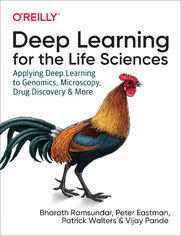Deep Learning for the Life Sciences. Applying Deep Learning to Genomics, Microscopy, Drug Discovery, and More - Helion

ISBN: 9781492039785
stron: 238, Format: ebook
Data wydania: 2019-04-10
Ksi─Ögarnia: Helion
Cena ksi─ů┼╝ki: 29,90 z┼é (poprzednio: 249,17 z┼é)
Oszczędzasz: 88% (-219,27 zł)
Deep learning has already achieved remarkable results in many fields. Now it’s making waves throughout the sciences broadly and the life sciences in particular. This practical book teaches developers and scientists how to use deep learning for genomics, chemistry, biophysics, microscopy, medical analysis, and other fields.
Ideal for practicing developers and scientists ready to apply their skills to scientific applications such as biology, genetics, and drug discovery, this book introduces several deep network primitives. You’ll follow a case study on the problem of designing new therapeutics that ties together physics, chemistry, biology, and medicine—an example that represents one of science’s greatest challenges.
- Learn the basics of performing machine learning on molecular data
- Understand why deep learning is a powerful tool for genetics and genomics
- Apply deep learning to understand biophysical systems
- Get a brief introduction to machine learning with DeepChem
- Use deep learning to analyze microscopic images
- Analyze medical scans using deep learning techniques
- Learn about variational autoencoders and generative adversarial networks
- Interpret what your model is doing and how it’s working
Osoby które kupowały "Deep Learning for the Life Sciences. Applying Deep Learning to Genomics, Microscopy, Drug Discovery, and More", wybierały także:
- Matematyka. Kurs video. Teoria dla programisty i data science 399,00 zł, (39,90 zł -90%)
- Java 9: Building Robust Modular Applications 332,50 zł, (39,90 zł -88%)
- Stream Processing with Apache Flink. Fundamentals, Implementation, and Operation of Streaming Applications 230,00 zł, (29,90 zł -87%)
- Matematyka. Kurs video. 285,00 zł, (39,90 zł -86%)
- Programming WCF Services. Design and Build Maintainable Service-Oriented Systems. 4th Edition 186,88 zł, (29,90 zł -84%)
Spis tre┼Ťci
Deep Learning for the Life Sciences. Applying Deep Learning to Genomics, Microscopy, Drug Discovery, and More eBook -- spis tre┼Ťci
- Preface
- Conventions Used in This Book
- Using Code Examples
- OReilly Online Learning
- How to Contact Us
- Acknowledgments
- 1. Why Life Science?
- Why Deep Learning?
- Contemporary Life Science Is About Data
- What Will You Learn?
- 2. Introduction to Deep Learning
- Linear Models
- Multilayer Perceptrons
- Training Models
- Validation
- Regularization
- Hyperparameter Optimization
- Other Types of Models
- Convolutional Neural Networks
- Recurrent Neural Networks
- Further Reading
- 3. Machine Learning with DeepChem
- DeepChem Datasets
- Training a Model to Predict Toxicity of Molecules
- Case Study: Training an MNIST Model
- The MNIST Digit Recognition Dataset
- A Convolutional Architecture for MNIST
- Conclusion
- 4. Machine Learning for Molecules
- What Is a Molecule?
- What Are Molecular Bonds?
- Covalent bonds
- Noncovalent bonds
- Molecular Graphs
- Molecular Conformations
- Chirality of Molecules
- What Are Molecular Bonds?
- Featurizing a Molecule
- SMILES Strings and RDKit
- Extended-Connectivity Fingerprints
- Molecular Descriptors
- Graph Convolutions
- Training a Model to Predict Solubility
- MoleculeNet
- SMARTS Strings
- Conclusion
- What Is a Molecule?
- 5. Biophysical Machine Learning
- Protein Structures
- Protein Sequences
- A Short Primer on Protein Binding
- Biophysical Featurizations
- Grid Featurization
- Hydrogen bonds
- Salt bridges
- Pi-stacking interactions
- Fingerprints
- Some implementation details
- Atomic Featurization
- Grid Featurization
- The PDBBind Case Study
- PDBBind Dataset
- Featurizing the PDBBind Dataset
- Conclusion
- Protein Structures
- 6. Deep Learning for Genomics
- DNA, RNA, and Proteins
- And Now for the Real World
- Transcription Factor Binding
- A Convolutional Model for TF Binding
- Chromatin Accessibility
- RNA Interference
- Conclusion
- 7. Machine Learning for Microscopy
- A Brief Introduction to Microscopy
- Modern Optical Microscopy
- The Diffraction Limit
- Electron and Atomic Force Microscopy
- Super-Resolution Microscopy
- Deep Learning and the Diffraction Limit?
- Preparing Biological Samples for Microscopy
- Staining
- Sample Fixation
- Sectioning Samples
- Fluorescence Microscopy
- Fluorophores and fluorescent tags
- Sample Preparation Artifacts
- The Mesosome: An Imaginary Organelle
- Deep Learning Applications
- Cell Counting
- Implementing cell counting in DeepChem
- Cell Segmentation
- Implementing cell segmentation in DeepChem
- Computational Assays
- Cell Counting
- Conclusion
- A Brief Introduction to Microscopy
- 8. Deep Learning for Medicine
- Computer-Aided Diagnostics
- Probabilistic Diagnoses with Bayesian Networks
- Electronic Health Record Data
- The Dangers of Large Patient EHR Databases?
- Deep Radiology
- X-Ray Scans and CT Scans
- Histology
- MRI Scans
- Learning Models as Therapeutics
- Diabetic Retinopathy
- Conclusion
- Ethical Considerations
- Job Losses
- Summary
- 9. Generative Models
- Variational Autoencoders
- Generative Adversarial Networks
- Applications of Generative Models in the Life Sciences
- Generating New Ideas for Lead Compounds
- Protein Design
- A Tool for Scientific Discovery
- The Future of Generative Modeling
- Working with Generative Models
- Analyzing the Generative Models Output
- Conclusion
- 10. Interpretation of Deep Models
- Explaining Predictions
- Optimizing Inputs
- Predicting Uncertainty
- Interpretability, Explainability, and Real-World Consequences
- Conclusion
- 11. A Virtual Screening Workflow Example
- Preparing a Dataset for Predictive Modeling
- Training a Predictive Model
- Preparing a Dataset for Model Prediction
- Applying a Predictive Model
- Conclusion
- 12. Prospects and Perspectives
- Medical Diagnosis
- Personalized Medicine
- Pharmaceutical Development
- Biology Research
- Conclusion
- Index





